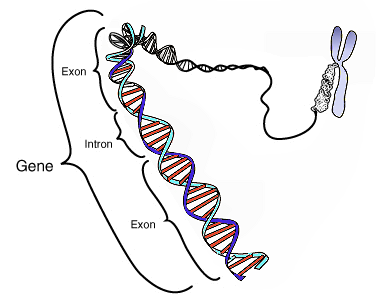Structural gene
Definition[edit | edit source]
As gene we refer to the section of DNA (sequence of nucleotides) on the chromosome, which is transcribed into mRNA. It is the basic unit of genetic information. One of the older definitions of a gene states that it is a stretch of DNA that codes for a protein. But today we know that not all genes code for proteins, so we distinguish them into several types according to their function:
- structural genes;
- RNA genes;
- regulatory genes.
Structural gene[edit | edit source]
A structural gene is a gene that carries information about the primary structure of one polypeptide chain. After transcription into mRNA, excision of introns and translation of this gene produces a protein - either with enzymatic, structural (building blocks of the cell) or signaling functions (immunoglobulins, receptors). In the human genome, these structural genes, i.e. DNA encoding polypeptides, represent only about 1.5%. Most of the genome consists of intergenic DNA, introns and untranslated regions of genes. The approximate length of the exon is about 120 bp, while the length of the intron is about 3500 bp - it follows that the exons, which are the basis for the creation of the protein, occupy a 30x smaller share in the genome.
Structural gene structure[edit | edit source]
As already mentioned, there are exons in the gene, carrying information about the primary structure of the polypeptide, and longer non-coding introns that are cut out. At the beginning and at the end of the gene there are also so-called UTR regions - untranslated regions.
In front of the gene itself, there is a promoter - a certain sequence where, among other things, transcription factors bind, and it is decided whether the gene will be transcribed or not.
Behind the promoter lies a transcription unit containing information for hnRNA, which is composed of introns and exons and after splicing, it becomes mRNA. At the very end of the transcription unit there is a terminator - this is another regulatory region, after its transcription the RNA polymerase detaches from the DNA matrix. As a rule, this sequence is preceded by a termination codon.
Odkazy[edit | edit source]
Related articles[edit | edit source]
Literature[edit | edit source]
- GOETZ, Petr. Vybrané kapitoly z lékařské biologie, díl 2. 1. edition. Karolinum, 2002. 139 pp. ISBN 80-246-0320-9.
- Princeton University, Farlex Inc.. The Free Dictionary [online]. [cit. 22.2.2013]. <http://www.thefreedictionary.com/structural+gene>.

